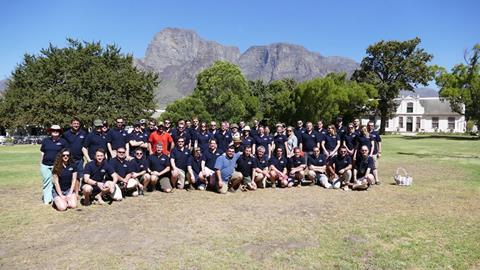
The Under 40s Fruit Growers’ conference chose South Africa as the venue for its 50th anniversary event, its first ever outside of Europe.
The biennial ‘conference’ – which is actually more like a residential field trip with presentations and visits – was set up in 1967 as a networking group for young people in the fruit growing industry. Its goals include providing a forum for debate and new ideas, introducing them to innovative production operations, broadening delegates’ knowledge beyond their own sectors, and helping them build social and professional networks.
The Under 40s has networking at its core, bringing together young growers of a variety of products, as well as people working for suppliers, service providers and in other sectors, and allowing them to share experiences and ideas about the fruit business of today and the future.
Sponsorship from the industry plays a vital role in making the overseas conference accessible to this group – not least for this year’s long-haul destination. At the end of February, 55 participants from across the UK fruit industry flew out for a week of visits around the Western Cape, the country’s fruit basket, which produces the lion’s share of its deciduous fruits.
On day one, Jacques du Preez, general manager for trade and markets at Hortgro, which represents South Africa’s stonefruit and topfruit industries, gave delegates an introduction to the SA fruit business at Spier conference facility, Stellenbosch.
Du Preez said that, combined with table grapes, stonefruit and topfruit are grown on more than 80,000 hectares of South African land, producing approximately 1.3 million tonnes of topfruit and 343,000t of stonefruit annually. Of this, some 46 per cent and 23 per cent respectively are exported, with the UK taking 13 per cent and 30 per cent of exports, making it South Africa’s largest single country market.
Hortgro has run a market development campaign in retailers and the media in the UK since 2009, which has helped build sales of South African fruit, with sales of stonefruit increasing by more than 70 per cent from the 2009-10 season to 2015-16.
With the week underway, the conference set off to visit a selection of the region’s leading growers, including Haygrove Heaven, Goosen’s, Du Toit and Fruitways; and the South African Plant Improvement Organisation (SAPO), a state-of-the-art R&D facility funded by the industry.
Charlie Dunn, the chairman of the Under 40s committee for the South Africa conference, says: “We tried to get a good balance between fruits – top, stone, soft – and we saw them all on the trip. Also the growers we visited ranged in size from 35ha to more than 1,200ha. It was important to include smaller growers so that all the delegates had sites they could relate to.
“The visit to SAPO was absolutely fantastic. The entomologists and other delegates in research-based jobs on the trip were interested of course, but there was something here for everyone. We saw and got to taste a range of emerging varieties of fruits and visit the labs.
“The trips to South African farms were inspirational. We were very impressed by the Fruitways operations – the sheer scale and efficiency of it is incredible.
“We also visited Du Toit’s next-generation farm, where they are trialling an atmosphere-controlled orchard. It’s completely covered, and as the temperature rises during the day the sides raise and the top opens to help cool the crops and keep air circulating. It has automatic shutters that stop the fruit being scorched by the direct sun; the cause of up to five per cent of their fruit being downgraded otherwise. Several of the farms are also experimenting with shade netting for this purpose, too, and misting systems to help control humidity.
“Haygrove was really good. They really have gone to the next level of production for soft fruit there and the attention to detail was incredible in both the growing and in the packhouse. It was typical of the operations we saw in South Africa: efficient, effective and future-looking.”
This progressive approach to producing top-spec fruit provided plenty of inspiration; interestingly some of the best examples of this came from the South Africans’ approach to problems that we aren’t facing in the UK – yet.
“Over there water is a big issue, so farmers have become extremely effective at conserving water and maximising use,” explains Dunn. “We spoke to one grower who had 90 days of water left and 100 days to go before rain was expected: it’s often very close to the wire. Being able to supply adequate sustainable water is one of the conditions when you’re purchasing land out there.
“This is something we should be looking at more in the UK. Water is such an important resource and, as populations grow into the future, it will become even more so. We also learnt about soils, an aspect which could have been easily overlooked. Growers at Boschendal, for example, have taken their initially poor soils and improved them dramatically. It got me thinking that we are sometimes lazy on this front in the UK: there is an opportunity to turn our very good soils into fantastic soils.”
This spirit of learning and delegates returning home full of new ideas and enthusiasm epitomises the Under 40s. Although this year’s long-haul made South Africa the most ambitious destination for the Under 40s to date, it proved that it can work well.
“Some said we couldn’t do South Africa for this conference, saying it was too expensive, or even dangerous,” says Dunn. “But thanks to our sponsors and a can-do attitude within the committee we did it and it was a fantastic success, one of the best Under 40s events yet.”



